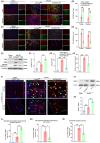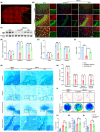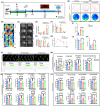S100A9 deletion in microglia/macrophages ameliorates brain injury through the STAT6/PPARγ pathway in ischemic stroke
- PMID: 39107960
- PMCID: PMC11303267
- DOI: 10.1111/cns.14881
S100A9 deletion in microglia/macrophages ameliorates brain injury through the STAT6/PPARγ pathway in ischemic stroke
Abstract
Background: Microglia and infiltrated macrophages (M/M) are integral components of the innate immune system that play a critical role in facilitating brain repair after ischemic stroke (IS) by clearing cell debris. Novel therapeutic strategies for IS therapy involve modulating M/M phenotype shifting. This study aims to elucidate the pivotal role of S100A9 in M/M and its downstream STAT6/PPARγ signaling pathway in neuroinflammation and phagocytosis after IS.
Methods: In the clinical study, we initially detected the expression pattern of S100A9 in monocytes from patients with acute IS and investigated its association with the long-term prognosis. In the in vivo study, we generated the S100A9 conditional knockout (CKO) mice and compared the stroke outcomes with the control group. We further tested the S100A9-specific inhibitor paqunimod (PQD), for its pharmaceutical effects on stroke outcomes. Transcriptomics and in vitro studies were adopted to explore the mechanism of S100A9 in modulating the M/M phenotype, which involves the regulation of the STAT6/PPARγ signaling pathway.
Results: S100A9 was predominantly expressed in classical monocytes and was correlated with unfavorable outcomes in patients of IS. S100A9 CKO mitigated infarction volume and white matter injury, enhanced cerebral blood flow and functional recovery, and prompted anti-inflammation phenotype and efferocytosis after tMCAO. The STAT6/PPARγ pathway, an essential signaling cascade involved in immune response and inflammation, might be the downstream target mediated by S100A9 deletion, as evidenced by the STAT6 phosphorylation inhibitor AS1517499 abolishing the beneficial effect of S100A9 inhibition in tMCAO mice and cell lines. Moreover, S100A9 inhibition by PQD treatment protected against neuronal death in vitro and brain injuries in vivo.
Conclusion: This study provides evidence for the first time that S100A9 in classical monocytes could potentially be a biomarker for predicting IS prognosis and reveals a novel therapeutic strategy for IS. By demonstrating that S100A9-mediated M/M polarization and phagocytosis can be reversed by S100A9 inhibition in a STAT6/PPARγ pathway-dependent manner, this study opens up new avenues for drug development in the field.
Keywords: S100A9; ischemic stroke; macrophage; microglia; neuroinflammation; phagocytosis.
© 2024 The Author(s). CNS Neuroscience & Therapeutics published by John Wiley & Sons Ltd.
Conflict of interest statement
The authors declare that they have no competing interests.
Figures






References
-
- Zhu L, Huang L, Le A, et al. Interactions between the autonomic nervous system and the immune system after stroke. Compr Physiol. 2022;12(3):3665‐3704. - PubMed
-
- Liu Y, Chen S, Liu S, et al. T‐cell receptor signaling modulated by the co‐receptors: potential targets for stroke treatment. Pharmacol Res. 2023;192:106797. - PubMed
Publication types
MeSH terms
Substances
Grants and funding
LinkOut - more resources
Full Text Sources
Medical
Molecular Biology Databases
Research Materials
Miscellaneous

